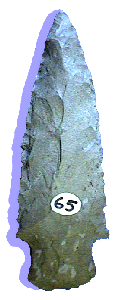

Point Type: FLINT
CREEK
Also See: Beacon
Island, Cotaco, Lamoka , Mud Creek, Pontchartrain
Location: Southeastern & Gulf United States
Associated Dates:
3000 - 2100 B.P. - Late Archaic - Early Woodland
Morphology: Stemmed
General Description: The Flint Creek point is a medium to large sized, narrow, thick, finely serrated, expanding stem dart or spear point. The blade is excurvate and the distal end is acute. The shoulders on the point can be horizontal, inversely tapered or tapered or barbed. The stem is thick and usually expanding and is crudely flaked by corner removal and the side edges of the stem are usually convex and rarely straight. The base is typically expanding and slightly rounded and can be, on rare specimens, straight. The stem may be thinned or left in an unfinished state with weathered cortex rind still present.
The point's overall thickness, expanding stem and unique edge flaking, especially near the point, are key identification marks for this type. The Flint Creek's flake scars are unique, and form a biface mini-serration. At the distal tip of the blade there is typically a bulb-like thickness and then a sharp dip in contour of the cross section. Flake scars from percussion flaking remain on both blade faces. The cross section is typically biconvex or occasionally plano-convex .
The distribution of the Flint Creek point type is still not cearly known. They occur in northern Alabama, southern Tennessee and northeastern Mississippi. They may extend into adjoining areas. The Flint Creek type is very similar to the Pontchartrain point type and may be a continuation of that type into early Woodland times or they may be contemporary, having different distribution areas. Pontchartrain points have straight to contracting stems while the Flint Creek has an expanding stem profile. Pontchartrain points are also often serrated.
The Flint
Creek's size ranges from 40 mm to 80 mm in length with an average of 51 mm. The
width ranges from 21 mm to 24 mm with an average of 23 mm. The thickness ranges
from 8 mm to 12 mm with an average of 10 mm. The stem width ranges from 16 mm to
20 mm. The stem length ranges from 11 mm to 14 mm.
The Flint Creek was named by James W.
Cambron in 1958 for examples which he recovered from a site along
the Flint Creek in Morgan County, Alabama.
About the Point Above: The point pictured above is a very large Flint Creek point made from a grey chert with lighter colored shiny flint inclusions near the base. The point measures 75 mm in length, 24 mm at the widest point (the barbs) and is 12 mm thick along the blade with the the base thinning to 8 mm. The stem is 20 mm wide at the notches and is 22 mm wide at the widest part. The base has been ground. This point was a surface find near the town of Childers Hill, Hardin County, Tennessee. Catalog Number 65-20-D
References: Baker, Overstreet, Perino (1, 4)
© Copyright 1997 - 2009 LITHICS-Net WWW.LITHICSNET.COM
Use Your Browser's BACK Button to Return to the LITHICS-Net Index.